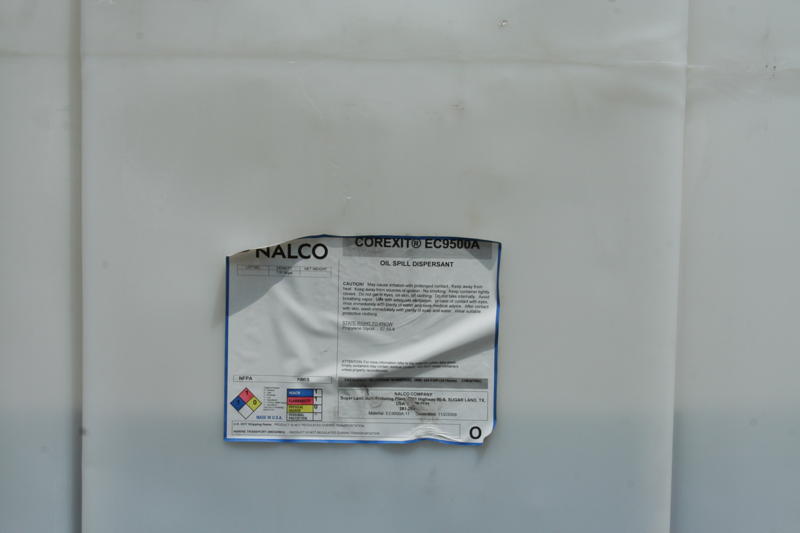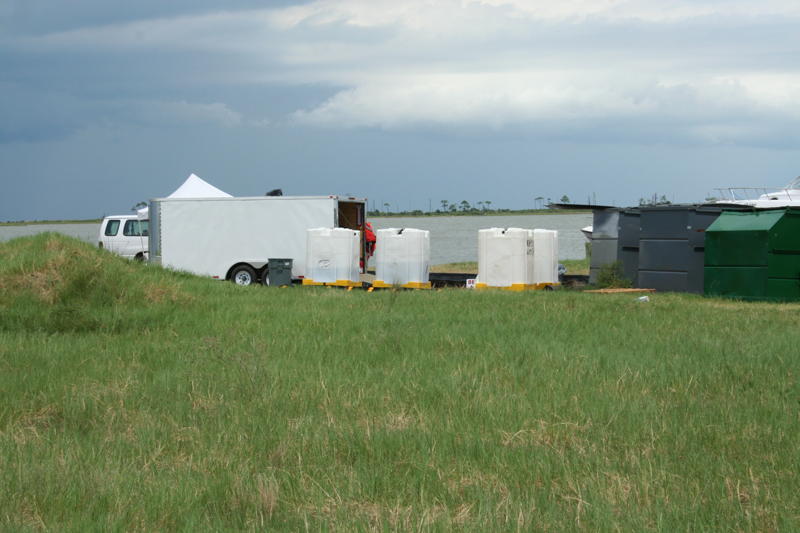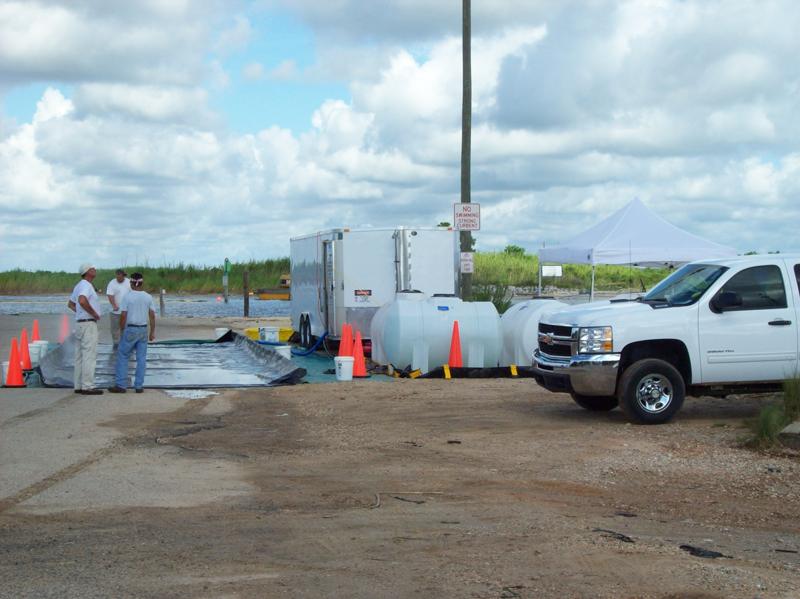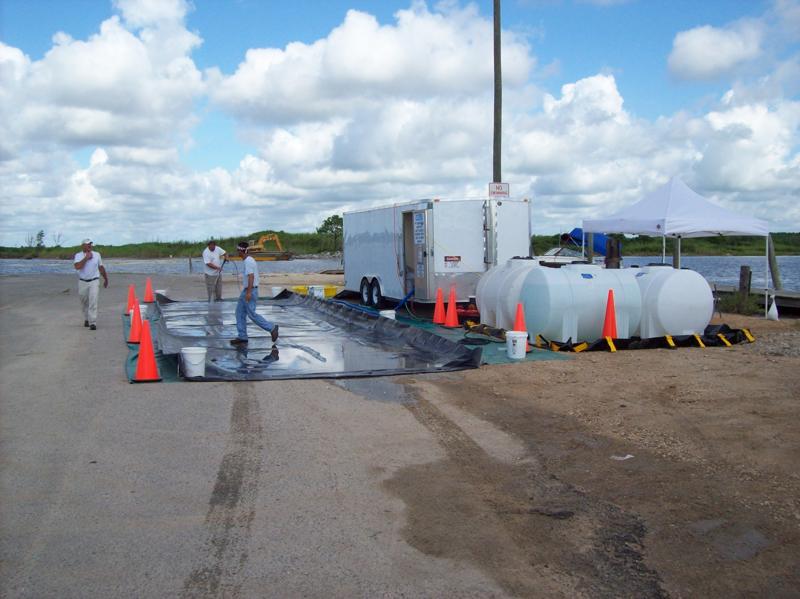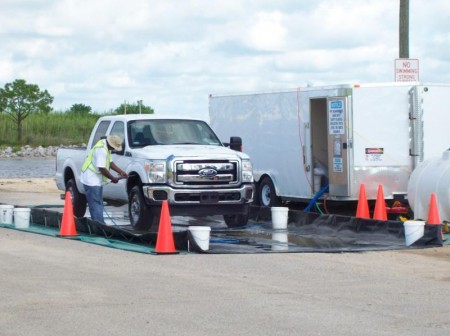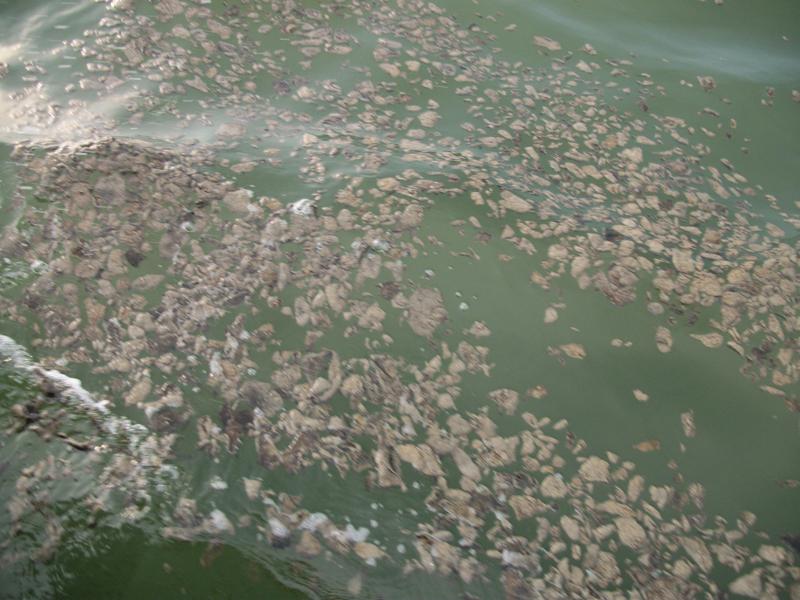Bob Naman is an analytical chemist with almost 30 years in the field, based in Mobile, Alabama. When WKRG News 5 gave Naman samples of water from the Gulf of Mexico, Naman found oil contamination, and one of his samples actually exploded during testing due – he believes – to the presence of methane gas or Corexit, the dispersant that BP has been using in the Gulf:
But the story only starts there.
A few days ago, Naman was sent a sample of water from Cotton Bayou, Alabama.
Naman found 13.3 parts per million of the dispersant Corexit in the sample:
That’s a little perlexing, given that Admiral Thad Allen said on August 9th that dispersants have not been used in the Gulf since mid-July:
We have not used dispersant since the capping stack was put on. I believe that was the 15th of July.
***
But I would tell you, there are no dispersants being used at this time.
More imporantly, Naman told me that he found 2-butoxyethanol in the sample.
BP and Nalco – the manufacturer of Corexit – have said that dispersant containing 2-butoxyethanol is no longer being sprayed in the Gulf. As the New York Times noted in June:
Corexit 9527, used in lesser quantities during the earlier days of the spill response, is designated a chronic and acute health hazard by EPA. The 9527 formula contains 2-butoxyethanol, pinpointed as the cause of lingering health problems experienced by cleanup workers after the 1989 Exxon Valdez oil spill, and propylene glycol, a commonly used solvent.
Corexit 9500, described by [Nalco’s spokesman] as the “sole product” Nalco has manufactured for the Gulf since late April, contains propylene glycol and light petroleum distillates, a type of chemical refined from crude oil.
Moreover, Naman said that he searched for the main ingredient in the less toxic 9500 version – propylene glycol – but there was none present. In other words, Naman found the most toxic ingredient in 9527 and did not find the chemical marker for 9500.
Since BP and Nalco say that no dispersant containing 2-butoxyethanol has been sprayed in the Gulf for many months, that either means:
(1) BP has been lying, and it is still using 2-butoxyethanol. In other words, BP is still Corexit 9527 in the Gulf
or
(2) The dispersant isn’t breaking down nearly as quickly as hoped, and the more toxic form of Corexit used long ago is still present in the Gulf.
Naman told me he used EPA-approved methods for testing the sample, but that a toxicologist working for BP is questioning everything he is doing, and trying to intimidate Naman by saying that he’s been asked to look into who Naman is working with.
I asked Naman if he could rule out the second possibility: that the 2-butoxyethanol he found was from a months-old applications of the more toxic version of Corexit. I assumed that he would say that, as a chemist, he could not rule out that possibility.
However, Naman told me that he went to Dauphin Island, Alabama, last night. He said that he personally saw huge 250-500 gallon barrels all over the place with labels which said:
Corexit 9527
Naman took the following picture of the label:
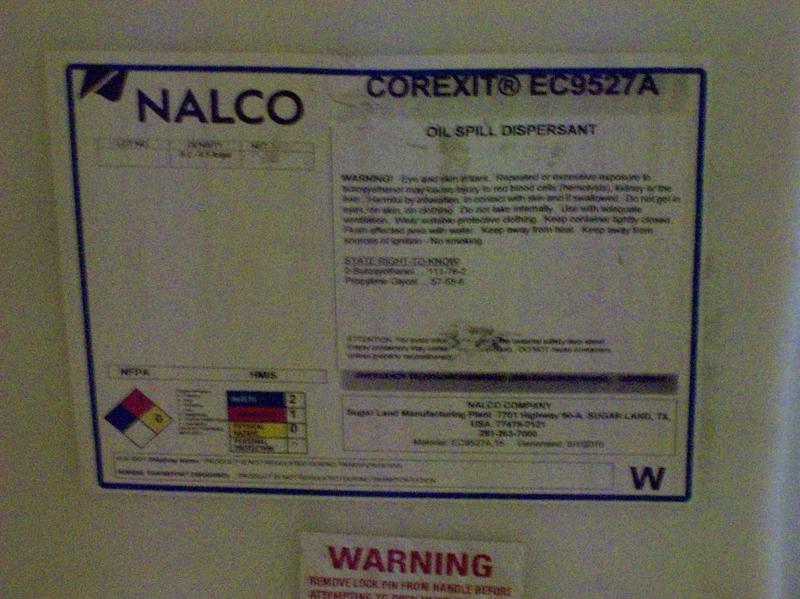
(The A version of the dispersant – 9527A – contains 2-butoxyethanol).
Naman further said he saw mercenaries dressed in all black fatigues, using gps coordinates, applying Corexit 9527 at Dauphin Island and at Bayou La Batre, Alabama. The mercenaries were “Blackwater”-type mercenaries, and Naman assumed they must have been hired either by BP or the government.
Naman also told me that Corexit 9527 is being sprayed at night, and that it is being applied in such a haphazard manner that undiluted 9527 is running onto beach sand. For confirmation of many of Naman’s claims, see this, this and this.
Naman sent me the following additional pictures showing Corexit pollution, use and storage (none show the mercenaries dressed in fatigues; apparently, such photos would have been too risky):
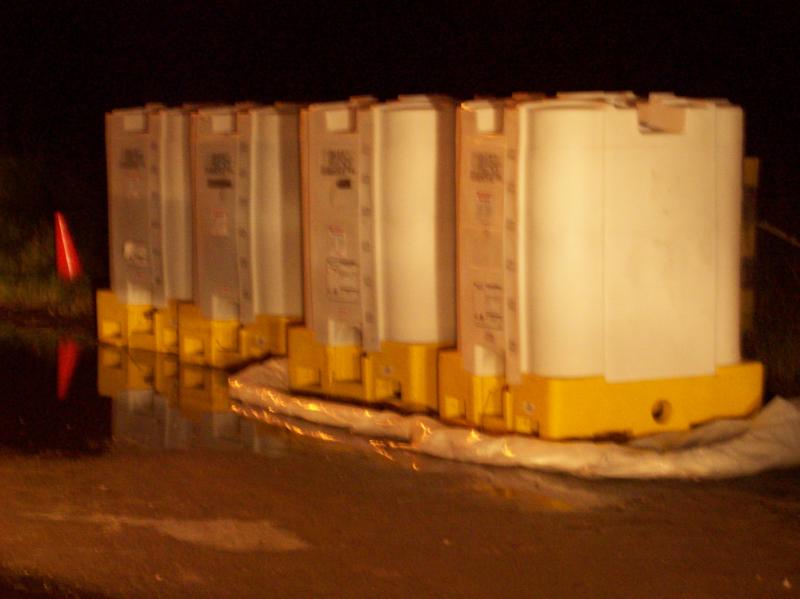
A bird eating a fish right next to the area where Corexit is handled:
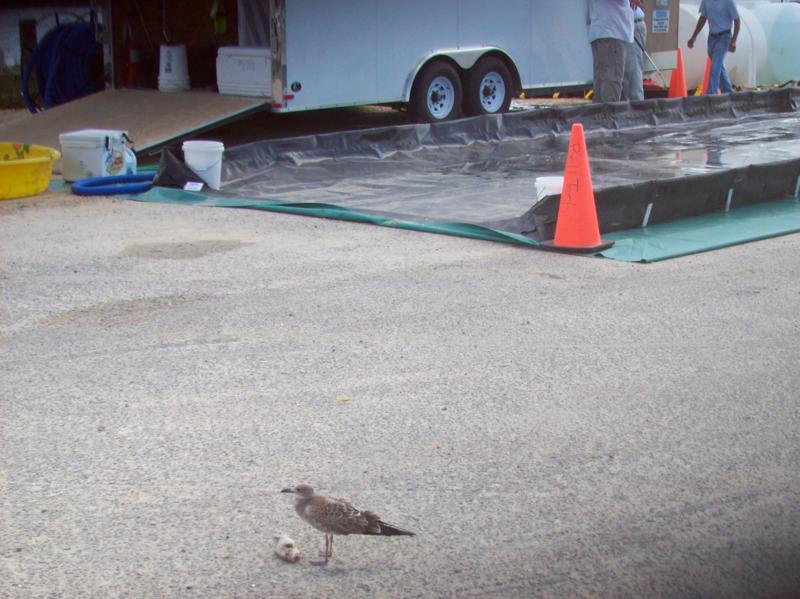
Naman also sent me the following picture showing a strange oil mixture in the Gulf:
Tuesday, August 24, 2010
Source: Washington’s Blog
Related articles:
– FDA admits NOT testing for MERCURY, ARSENIC, or any other TOXIC HEAVY METALS in Sea Food
– Gulf claims chief Ken Feinberg says BP no-sue rule was his idea, takes control of BP’s $20bn fund
– Matt Simmons Dies In An ‘Accidental Drowning’ At His Home
– Matthew Simmons: ‘We’ve Now Killed The Gulf Of Mexico’ (Flashback)
– Gulf Oil Blowout: Matt Simmons Was Right!
– Loop Current in the Gulf of Mexico Has Stalled From BP Oil Disaster! (!)
– Scientists: Evidence Of Gulf Oil And Dispersant Mix Making Its Way Into The Foodchain
– The Growing Health Crisis in the Gulf of Mexico:
Corexit also contain arsenic, cadmium, chromium, mercury, cyanide, and other heavy metals. Dispersing oil with it increases toxicity 11-fold ….
People who work near it are hemorrhaging internally. And that’s what dispersants are supposed to do.EPA now is taking the position that they really don’t know how dangerous it is, even though if you read the label, it tells you how dangerous it is. And, for example, in the Exxon Valdez case, people who worked with dispersants, most of them are dead now. The average death age is around fifty. It’s very dangerous, and it’s an economic-it’s an economic protector of BP, not an environmental protector of the public.
– Gulf of Mexico BP Oil Rig Blast: Safety Alarm Was Off
– And Now: BP Plans Deep-Water Drilling Off Libya
– Rachel Maddow: The Gulf Of Mexico Déjà Vu (Must See!)
– Matt Simmons: BP Cap Is A Fraud – ‘It’s The Biggest Cover-Up We have Ever Seen’
– Gulf Of Mexico Water Sample EXPLODES! Other Samples Prove To Be Toxic
– BP Oil Blowout: All States Along Gulf Of Mexico Affected By Slick
– U.S. Senate Traitors Block Investigative Power for Oil Spill Commission
– And Now: BP admits failing to use industry risk test at any of its deepwater wells in the US
– CNN: 1st Amendment, Free Press Suspended Near Gulf Disaster Area
– Gulf of Mexico Disaster: BP Slick Covers Dolphins and Whales
– BP burns rare sea turtles alive, blocks efforts to save them
– Matt Simmons: ‘We’re going to have to evacuate the gulf states.’
– US Scientist: Methane In Gulf ‘Astonishingly High’, As Much As 1 Million Times The Normal Level
– BP Plans To Dump All North Sea Assets In Dramatic Attempt To Cut Costs
– BP Blocking Media Access To Workers (Video)
– BP Official Admits to Damage BENEATH THE SEA FLOOR
– BP Buys Search Term ‘Oil Spill’ From Google
– BP CEO Tony Hayward sold £1.4 million of his shares weeks before Gulf blowout
– Goldman Sachs Sold 44% Of Its BP Stock 3 Weeks Before Gulf Blowout
– Feds and BP Withheld Videos Showing Massive Scope of Oil Spill
– Gulf of Mexico Oil Spill Solution Restores Environment in Just Six Weeks
– BP’s ‘brilliant’ CEO Tony Hayward clashes with scientists over deep sea oil pollution
– BP’s top kill effort fails to plug Gulf oil leak
– Gulf of Mexico Oil Apocalypse Creates Underwater Nightmare
– Gulf of Mexico clean-up boats recalled after crews suffer health problems
– SPECIAL REPORT: Civil fine in Gulf spill could be $4,300 a barrel
– Gulf of Mexico Oil Spill Health Hazards
– Fishermen get severly ill from clean-up work in Gulf
– NASA Images Show Oil Entering Loop Current
– New NASA Image of Gulf Oil Moving Towards Atlantic Ocean
– Worry That Gulf Oil Spreading Into Major Ocean Current
– AP IMPACT: Fed’l Inspections on Rig Not as Claimed:
The federal agency responsible for ensuring that an oil rig in the Gulf of Mexico was operating safely before it exploded last month fell well short of its own policy that inspections be done at least once per month, an Associated Press investigation shows.
Since January 2005, the federal Minerals Management Service conducted at least 16 fewer inspections aboard the Deepwater Horizon than it should have under the policy, a dramatic fall from the frequency of prior years, according to the agency’s records.
Scientists studying video of the gushing oil well have tentatively calculated that it could be flowing at a rate of 25,000 to 80,000 barrels of oil a day. The latter figure would be 3.4 million gallons a day.
– Beyond Stupid: BP CEO Tony Hayward:
“The Gulf of Mexico is a very big ocean. The amount of volume of oil and dispersant we are putting into it is tiny in relation to the total water volume.”
– US Oil Spill: Scientists and Fishermen Alarmed Over Chemical Dispersants:
Approximately 325,000 gallons of dispersant have been deployed so far in BP’s effort to break up the spreading oil slick before it hits the fragile Gulf coast, and over 500,000 gallons more are available.
– Rig firm makes $270m profit from Gulf of Mexico oil spill
– US not accepting foreign help on oil spill
– Gulf of Mexico Oil Spill: New NOAA Projection Map; BP’s High-Stakes Mission; And More News
– Gulf of Mexico Oil Spill: The Halliburton Connection:
The company acknowledged Friday that it had completed the final cementing of the oil well and pipe just 20 hours before the blowout last week.

